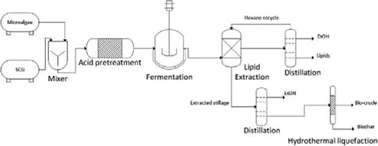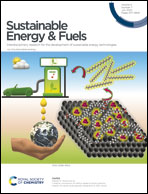An alternative biorefinery approach to address microalgal seasonality: blending with spent coffee grounds
Abstract
An effective method for the production of fuels and chemicals from microalgae is to ferment the carbohydrate fraction, extract the lipids and convert the resulting solids through hydrothermal liquefaction (HTL). In this process, known as Combined Algal Processing (CAP), multiple fuel precursors are produced effectively. However, one of the key challenges associated with a microalgae-based biorefinery is the reduced productivity of algae in the colder seasons. In this investigation, the potential for spent coffee grounds (SCG), a potentially valuable waste stream, to be blended with biomass from the microalgae Scenedesmus acutus (HCSD) to make up for the productivity shortfalls in periods of lower microalgae productivity to maximize the capacity for downstream equipment throughout the year was evaluated. Two different blend ratios were compared to only microalgae biomass or SCG, one representing winter season (40% microalgae and 60% SCG – blend 1) and another representing autumn and early spring (60% microalgae and 40% SCG – blend 2). Pretreatment of the blends showed higher monosaccharide release yields compared to microalgae alone, with an increase in mannose and galactose specifically. In the fermentation of the pretreated slurries, all the monosaccharides were consumed, resulting in ethanol titers of up to 23 g L−1 for the SCG blend, compared to 14 g L−1 ethanol for the algae alone. The lipid extraction from the blends resulted in yields of 95.5–99.7% (which translates to 173.8–193.5 kg per tonne of dry biomass processed in this biorefinery scenario) compared to 92.2% in HCSD (216.2 kg per tonne of dry biomass) and 68.1% in SCG (90.8 kg per tonne of dry biomass) alone. The residual solids left after fermentation and lipid extraction were converted via hydrothermal liquefaction (HTL) to produce bio-crude. The bio-crude yield was higher for microalgae (24.6%) than for the two blend cases (blend 1–17.5% and blend 2–19.7%). Theoretical energy calculations showed that the addition of SCG gave similar yields of fuel (gallon of gasoline equivalents) from the blends when compared to microalgae alone (94.7–96.5% depending on the blend of SCG). This work demonstrates that SCG can be easily incorporated with microalgae into a combined processing methodology and can therefore be used effectively during periods of lower availability of microalgae maintaining maximum operating levels of the conversion process equipment year-round. Moreover, co-processing algae with SCG not only leads to increased ethanol titers in the fermentation but also improves the lipid extraction yields.



 Please wait while we load your content...
Please wait while we load your content...